

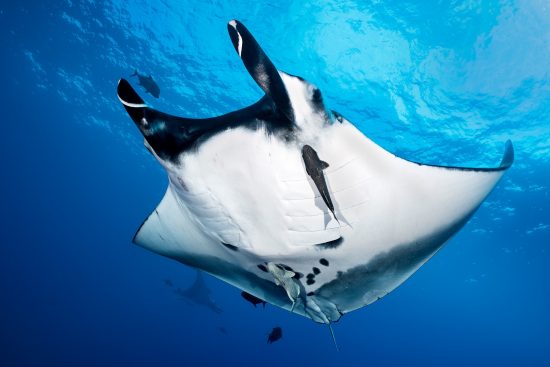
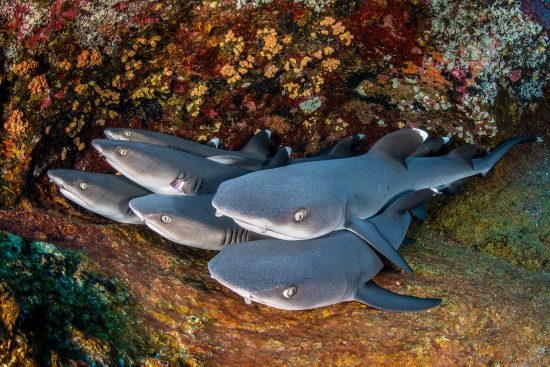
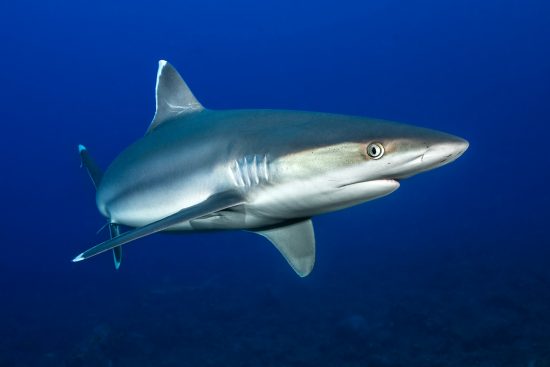
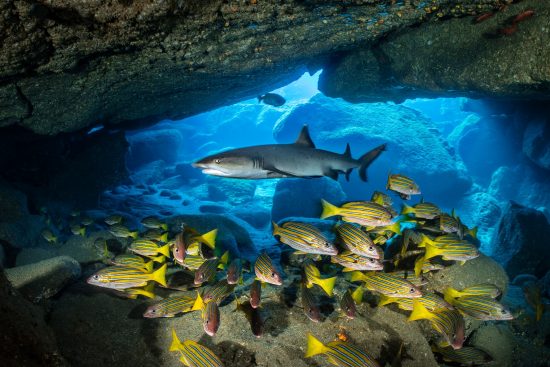
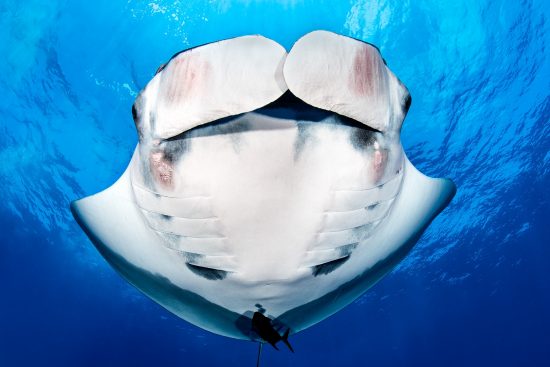
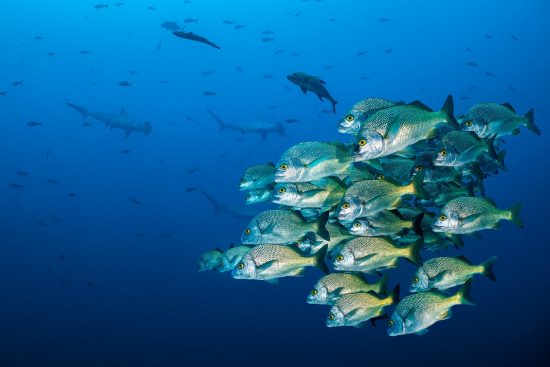
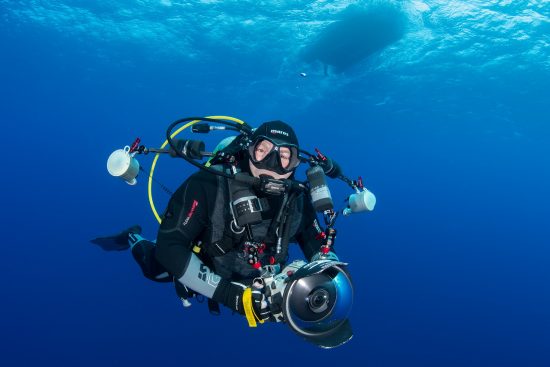
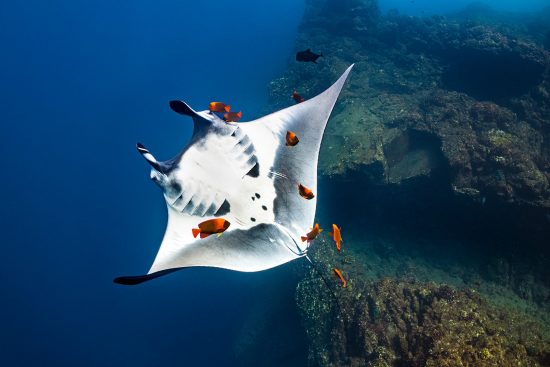
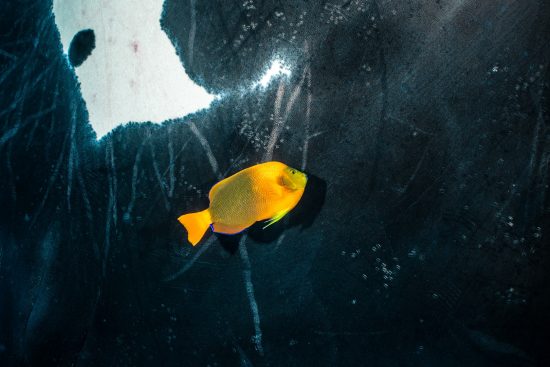
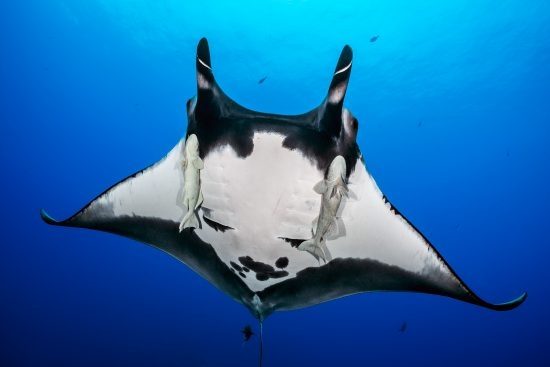
There isn’t a more wonderful ocean creature to spend time with than the manta. Despite their huge size, these graceful rays fly through the ocean with balletic delicacy. No matter how many times you have seen mantas, you always want to see more. Like a movie star walking into a crowded party, they are creatures that we cannot take our eyes off. They are also intelligent - a manta’s brain is the largest of any fish, 10 times the size of that of the even larger filter feeding giant, the whale shark.
Mantas are curious and playful, and studies have shown that they are one of the few animals able to recognise themselves in a mirror. Their eyesight is excellent and there is no doubt that those big eyes are looking back at us when we watch them. Unsurprisingly, loads of divers list them as their favourite species in the ocean.
There are actually 2 species of manta – reef mantas and oceanic mantas (and scientists are currently trying to figure out if the reef mantas of the Caribbean might be a third). Their Latin name has recently been changed from Manta to Mobula, but they still keep manta as their common name and are easily distinguished from mobulas as their mouth is forward facing rather than underslung.
The flattened shape of mantas come from their ray heritage, an adaption for living on the seabed in the past, but about 30 million years ago, mantas and mobulas took off again and became mid-water fliers, even capable of leaping clear of the water.
As a diver, I more commonly encounter reef mantas, so I was excited to be heading to the tongue twisting Revillagigedo Islands (commonly called Socorro). These uninhabited volcanic islands way out in the Pacific, off the coast of Mexico, serve up giant oceanic mantas on most dives. Socorro offers plenty of other diving thrills as you’d expect of a remote speck of land in the oceanic outpost. The area has lots of sharks, we saw tiger, hammerhead, silky, silvertip, whitetip and Galapagos, turtles, schooling fish, (and on a previous trip in February, many humpback whales from the boat). But I was there, on the liveaboard Solmar V, for the mantas!
Despite being in the tropics, these volcanoes rise up from the ocean floor, pushing cool, nutrient-rich, deep water to the surface, kickstarting a flourishing ocean food chain. Oceanic conditions and cool water made this trip a bit more dive gear intensive. For the cool water (usually a low 20°C) I took my Flexa Graphene semi-dry 7mm suit. This suit is both super warm and super flexible, but it was probably a bit much on this occasion, and I am sure I would have been warm enough following fellow Mares Ambassador Noam Kortler’s advice of using the Flexa 8.6.5. I don’t actually have one, but I mention it if you are planning your own trip. Because it was open ocean diving, I took my heavyweight BC, the Dragon SLS, which fits like a hug and is always a pleasure to dive in. I saved luggage weight with the new SXS 62X regs. As a photographer, I am always trying to save luggage weight! These new regs breathe really well underwater (even when I was fighting strong currents at depth), although they do honk when I breathe at the surface. I really liked the side exhaust which keeps bubbles away from the space between my mask and my camera’s viewfinder, and they are already packed for my next trip to the Red Sea.
I don’t often dive in freediving fins, but always take them on trips to the East Pacific Ocean. They give that extra burst of speed when needed for getting into position for a close pass. Chasing mantas never works, but swimming into space means you get backgrounds free of people when the mantas come to you. In Socorro, the mantas are always curious and check out everyone in the water, so it is just a case of finding some space. The less you move when they approach, the closer they will come. I really like my basic Razor fins. I know Mares has cooler fins, but these just work and are not too stiff for swimming with them all through the day. I also wore my Tek Gloves on a few dives when our guides told us that the plan for the dive involved clinging onto the rocks in the current, but my suit was so warm I didn’t need them at other times. These fingerless gloves might have been designed for tech divers to fiddle with their techie stuff, but they are also excellent for photographers needing to adjust camera settings.
We saw mantas on every site that we dived, and many dives had multiple individuals. Some were really huge, they truly felt a scale up from the reef mantas I was photographing in the Maldives recently. Also, it is great to meet them in midwater, rather than hunkered down on a cleaning station. Not only do the oceanic mantas come in the common colour variations (black, chevron and white) they also have very individual personalities, some super curious, some disinterested.
A real highlight of the diving on this trip was seeing the mantas being cleaned by bright orange clarion angelfish. There can’t be a more colourful cleaner fish anywhere in the ocean! When they spot a manta coming in, these dayglow fish race out from the rocks into the blue. It is amazing how small these quite large angelfish look when they are buzzing about a giant manta. I wasn’t convinced how much actual cleaning they were doing – they just seemed to be pecking at the mantas, but they manta’s clearly enjoyed the treatment and even queued up for the attention.
 Alex
Alex 4th July 2022
4th July 2022